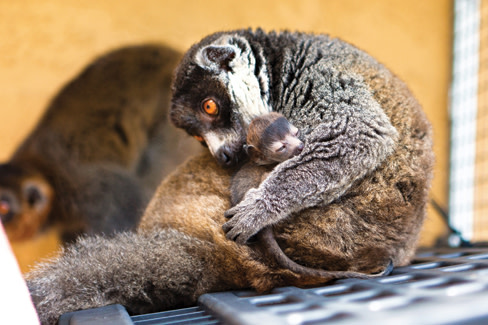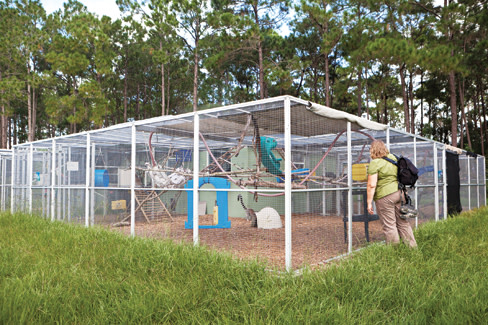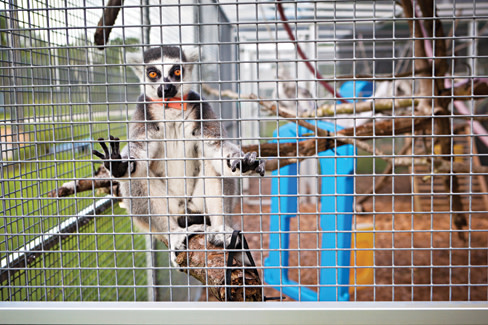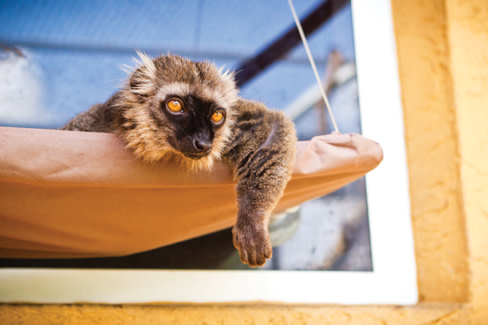The Loneliest Lemur on Earth

Within my first five seconds observing the lemurs at the Lemur Conservation Foundation's Lemur Reserve, just half an hour outside of Sarasota, I find myself betrothed to—or at least going steady with—a female ringtail named Medella. The clinical description of what transpires during our introduction, according to the highly amused staffer who is my guide, is "presenting." That, however, is a white-glove term for a scenario whose reality can be more accurately described by saying, "Medella vaults onto her forepaws like an Olympic gymnast, hind legs maximally akimbo, and thrusts her pelvis into the chain link fence while she twerks and spasms and thrusts her genitalia at me with such force it's as if she is trying to destroy not merely the fence itself but the entire conspiracy of folly and prejudice that prohibits interspecies romance." As a spectacle it is both astonishing and unsettling, but it augurs the rich variety of surprises that are to come in the next 24 hours—the next rain-lashed, storm-tormented, howl-ridden 24 hours—and I can't help thinking to myself:
I am making a terrible mistake.
I am not an outdoorsy type, and my ego had tricked me into agreeing to spend an observational overnight sojourn at the reserve deep in the Floridian wilderness with nothing for nocturnal protection but a tent. Now I find myself fearing not just for my chastity but also for my safety, for although they look plenty adorable, lemurs also have dexterous hands, insatiable curiosity and teeth like quarter-inch carpet tacks.
If a spurned lady lemur craved access to my tent for amorous and/or vengeful reasons, I have no doubt that she could obtain it.
And there are many other signs of doomy forewarning, too. For starters, the reserve is in such a remote location that my cell phone doesn't work. The LCF also doesn't have a discernible street address—just a P.O. Box and a zip code—and is therefore unfindable by GPS and, presumably, the emergency services workers who will need to arrive later to collect my ravaged corpse. Then there are the storms. Terrifying, cataclysmic storms. Storms that are so torrential that they have turned the long dirt road leading to the reserve into a mud bog so impassable it is as if the gods of pathetic fallacy themselves are telling me to turn my sad, soft, citified self around.

But when I finally power into the reserve's long driveway, my car's tires truffling and whinnying in the chowdery muck, I encounter the spookiest thing of all: a massive electrified fence sectioning off immense swathes of forest to create a free-range enclosure. As I am apprehending this sight I suddenly hear—through my closed windows and over the snare-drum rataplan of rain crashing against my car—the most terrifying screeching I have ever heard. Naturally, the first thing I think to myself is: remote location cut off from all outside help? Check. Unsturdy-looking electric fences sealing off clever wild animals with pointy teeth? Check. Thunderous storms that promise to swamp vehicles, tear down fences, and incapacitate all safeguards and communication with the outside world? Also check.
It all makes me feel like I'm starring in Jurassic Park V: Rise of the Lemurs.
Over the next 24 hours, however, I will find out that this judgment is, of course, dreadfully wrong. Lemurs, it turns out, are not bloodthirsty, scheming, sex-crazed monsters hell-bent on enslaving and molesting humans. Lemurs are prosimians, a group composed of smaller primates that have more primitive features than monkeys or apes, including—sorry, guys—a littler brain than simians of comparable size. But despite their bantam brainpans, lemurs are extremely alert and inventive. They have articulate, humanlike hands and special anatomy evolved for grooming, including an array of comblike teeth and a creepily serrated second tongue. There are over a hundred different species of lemur, most of which don't get much larger than a house cat. And they are all so irresistibly cute, with the most mesmerizing eyes in the animal kingdom, that you can understand why they have become a favorite of animated kids' movies and makers of stuffed animals.
Although there is some dispute about their origins—recent fossil discoveries indicate that prehistoric lemurs may have existed in North America—the current consensus is that 62 to 65 million years ago lemurs rafted from Africa to the island of Madagascar, where they have evolved in near-total seclusion ever since. What is not in dispute, however, is that their native habitat is rapidly disappearing via the depredations of the pet trade, aggressive deforestation, climate change and the political unrest that has characterized Madagascar's government since an ill-conceived coup in 2009. The country's poverty is so profound that in many cases lemurs are hunted for their meat.
So in addition to being some of the most charismatic animals on earth, lemurs are now also among the most critically endangered. At least 17 species have been made extinct in the 2,000 years since humans first landed on Madagascar, including the truly redoubtable giant sloth lemur, which grew to the size of a gorilla. Today many more lemurs are coming direly close to extinction themselves, including the northern weasel lemur, which has no more than 19—I repeat: 19—living members. Much of the damage done to their habitat in Madagascar is irreversible, and many other species of lemur may soon be gone forever.
And the Lemur Conservation Foundation right here in Myakka City—the only facility of its kind anywhere on earth—represents the lemurs' last best chance for survival.

There is another important way in which the LCF is different from Jurassic Park: It is not open to the public. It is not a zoo; gangs of excited children and exhausted parents will never form lines to gawp at the lemurs eating monkey biscuits or hanging upside down from the fire hoses that festoon the trees. Lee Nesler, the executive director and CEO, says that soon, when broadband finally comes to the boonies, there will be interactive educational opportunities for the public—GoPro lemur cams whose footage can be followed online, for example—and there is even talk of opening a lemur gift shop in downtown Sarasota. But for now the LCF is a nonprofit captive breeding program whose mandate is to maintain a viable population with optimum genetic diversity for the preservation of as many species as possible. Instead of photo-ops and birthday bashes it stresses conservation, field study, education, and, ultimately, if all goes well—which is far from certain—the reintroduction of lemurs back into the wild.
This ambitious plan is being carried out by a small staff of scientists, interns, administrators and volunteers. Visiting researchers also come from all over the world, and the foundation staff is in frequent contact with the prestigious Duke University Lemur Center and initiatives in Madagascar itself.
When the rain stops hammering down briefly, my tour group—two high school teachers, a researcher preparing for graduate school, and me—is finally allowed outside, and I see that the immense grounds actually feature two separate enclosures. Each is about 10 acres—plenty of space, since each lemur community only requires about three acres of territory. When we enter the free-range enclosure it becomes clear that at the LCF, the lemurs come first. We aren't allowed to approach them, of course, or touch them ourselves—although it is OK if a lemur touches you, which is why I can report that they have tickly hands and wet noses just like dogs—and when a crew of ringtails approaches we all have to stand back like chastened paparazzi to allow the VIPs to pass unhindered. The good people at the LCF are so serious about protecting their wards that every time you pass from one area of the reserve to another you must bathe your feet in a special disinfectant wash that has the unsettling, lethal-sounding name Virkon-S. So frequent is this activity that if you were to film everyone passing through any doors on time lapse film it would look like a Riverdance competition.
The LCF also does its best to recreate the experiences of the lemurs' homeland in rural Florida. They have planted many species of plants found natively in Madagascar—persimmon, bamboo, mango—and every single lemur is treated every day to "enrichment" exercises meant to provide mental stimulation by reproducing some of the problem-solving challenges that lemurs in the wild would have to overcome in order to survive. Mostly this takes the form of hiding their food inside some kind of puzzle device, like the interior of a clogged paper towel cylinder.
There are two varieties of food referred to as "crunch" and "chow," and I can affirm that both have the visual appearance of cow patties and the taste of something you would never want to try again. Many lemurs get their meals embellished with baby food or medications, milk thistle or glucosamine or similar. Claire, a collared lemur who suffers from cancer, has her food enhanced with sugar, Pepcid AC, and Metacam for pain. Merced, a mongoose lemur afflicted by a mysterious ailment called gastrointestinal mortality syndrome that killed his whole family, gets his meals laced with acidolphilus, which I can only hope tastes better than it sounds. And all the lemurs get a steady diet of "browse," which can be any kind of the 30ish different varieties of edible and healthful vegetation that they cultivate at the LCF.
This is about as far as I get in my lemur education before the storm picks back up and our little group is forced to retreat inside, but not before I am informed that the last time they had such a storm some of the fences were damaged and subsequently breached by "a certain number of alligators." I point out that I am supposed to sleep that very night out in the wilderness inside of something that has the camouflage power of a lit emergency flare and the structural integrity of a bathing suit.
Everybody laughs but me.

After grasping the expansiveness of the operation at LCF and the global importance of its mission, I find myself wondering what kind of visionary decided to create it. At lunch I find out.
Penelope Bodry-Sanders, the reserve's founder, who retired as its executive director in 2010, has a biography that sounds like it was invented by Dominick Dunne in an especially fanciful bout of fabulism. After working as a nun for three years, she quit and became the frontwoman of a folksy rock band called Tamalpais Exchange; in 1969, after being discovered by the producers of the Velvet Underground, she moved to New York City. When her band's album failed to thrive, Bodry-Sanders became an actress, on and off Broadway, for 12 years. Then she took a position at the American Museum of Natural History, where she worked in various capacities for nearly two decades until one fateful day in 1996 when she visited Madagascar and saw a lemur.
"And that was it," she says simply.
Next thing you know, Bodry-Sanders found a place with a climate and geography suitable for lemurs in the wilds of rural Florida and left behind her New York City life of Broadway openings and black-tie events and started to build a lemur reserve. She started with $35,000 and, no doubt, a snickering chorus of detractors and doubters. Today her creation is a sophisticated free-ranging Eden—or maybe a selective Noah's Ark—for the world's most critically endangered primates.
Outside the storm is still raging with crashing curtains of rain that sound like they threaten to knock out the windows, and yet, even over this din I can still hear that insane screeching that greeted me upon arrival at the LCF. Now, however, I know that this is merely the routine vocalization of red ruffeds, who don't much care for thunderstorms, either. It's as if they're saying to their buddies in the far enclosure, "Hey, we're OK over here! You guys OK over there?"
As I am musing on their chumminess, something happens that is so metaphorically pinpoint-perfect that it requires me to assure you that it is factually true.
"Hey, Penelope," I say. "What's that tattoo on your hand?"
"It's the Indian goddess Durga."
"Oh. I don't think I know that one. What does she do?"
Bodry-Sanders gives me a look, serene and utterly sincere.
"She saves the world from destruction."

When the punishing rain stops a few hours later, I am finally able to spend real quality time with the lemurs themselves, and I learn empirically what I have already intuited: Every lemur is an adorable lemur. They have a hilarious kind of locomotion, bounding around on their hind legs Tiggerishly, then breaking into a scrambling, four-legged run, then launching themselves into the trees. They don't have lips, and when they eat they have to tilt their heads way back and gyrate them around—it makes them look as if they're avidly tracking the flight pattern of a swarm of drunken bumblebees—so that food doesn't fall out. They engage in sunbathing during which they sit on their haunches, arms uplifted prayerfully, eyes glazed over in prosimian pleasure, and soak in the rays. And although they are deeply laid-back—"They are the Rastafarians of primates," says Nesler—their facial expressions are vivid and comical and their brilliantly colored eyes express such excitement that they always seem to be regarding the world with all caps: "IT'S YOU!" their expressions seem to say. "OH MY GOD IT'S REALLY YOU! WHERE HAVE YOU BEEN ALL THIS TIME?" And even just sitting around, lemurs appear curious and mystical like furry little Buddhas. They are the stargazers of the primate world, the theoreticians and metaphysicists and poets.
Still, nearly all the workers at LCF admit that they have their favorites, and after a few hours with every lemur in the place, so do I. It's hard not to like my fervent suitor Medella, of course, but she is a pet trade lemur, and they often become prone to aggression and misadventure when they hit puberty. True, I had the same problem at that age myself, but I still prefer Molsen, the fattest lemur at just over eight pounds, and Tsikey, the only male who enjoys any authority in the matriarchal world of lemurs. Then there's Ravena, the red-ruffed lemur who dislikes climbing down trees and executes death-defying leaps from pine to pine on dangerously bendable small-gauge branches just to reduce the distance of her descent.

My absolute favorite, however, has to be Silvio, a baby mongoose lemur whose mother refused to nurse him or allow him to cling. As we know from the harrowing experiments of Dr. Harlow, primates raised without direct maternal care become skittish and fearful and sickly, but thanks to the attention he receives at the LCF, Silvio's development is actually slightly ahead of schedule. Chief among his therapies is the use of maternal surrogates, which are comprised of nearly a dozen supercozy stuffed animals, all of which the staff have had scented by Silvio's mother. The surrogates are placed, both outdoors and indoors, at gradually increasing distances in order to encourage Silvio to explore farther. As for his reluctant mother, it's too late to subject her to any kind of conditioning for Silvio's sake, but she will eventually be put on a therapeutic regimen that will include the application of hairclips of increasing sizes on her body to help her become accustomed to the sensations of clinging. This way, she will be better prepared for motherhood when she breeds again next year.
I realize that, taken together, all the lemurs at the LCF are like a cast of hard-luck Dickens orphans. Some are sickly, like Merced; some are moribund, like Claire; some come from broken homes, like Medella. Some are star-crossed, some suffer accidents, and I am beginning to wonder if all are just plain old doomed. After all, despite the foundation's heroic efforts, even a cursory Googling of current events in Madagascar reveals the following: coup d'etat, swarms of locusts, food shortages, withdrawal of foreign aid, population bomb, illegal logging, extinctions, habitat shrinkage, erosion, starvation, the Black Plague.
No matter how healthy and prepared their lemurs are for reintroduction, what do you do if there simply is no home to which they can return? Is it a philanthropic success to preserve a species just so it can be kept on display in captivity? Does that kind of existence justify the expenditure of such tremendous resources of time, money and effort?
These are the unhappy questions that I put to the table when we all go to dinner at one of Myakka City's two restaurants. At first the table goes quiet, and I fear that I have voiced the ugly truth they all strive to avoid contemplating, but then Lee Nesler responds.
"There is hope, absolutely," she insists. "That hope is the interest we can create in the Madagascar people to save their flora and fauna by employing them in the sister reserve we are building in Tampolo and giving them an income outside of the destruction of the forest, which leads to the extinction of lemurs and other animals. Providing ways to increase their agricultural yields to feed their families and sell the extra will provide the structure to help take care of the villagers surrounding the reserve."
The sister reserve in Madagascar, Nesler explains, is already making a big difference in the local community, including training by the LCF's foresters to improve suistainable methods of fishing, beekeeping and farming. In short, they are working fervently on both ends of the problem, striving mightily to preserve the natural habitat in Madagascar while managing a free-range research laboratory-cum-finishing-school in Florida so that when the time comes for reintroduction, their lemurs will be up to the adventure.
This is good news. This is heartening news. But there is another piece of good and heartening news: The storms are so bad, Nesler says, that she cannot in good conscience let me sleep in the tent because of the threat of gators and wild pigs. I protest very manfully, but secretly I am, of course, relieved.
So I accept the offer of a futon belonging to a grad student intern who's away for the week, and let me tell you, there is nothing like a grad student's futon to spur a little existential musing. Long into the night I contemplate the following questions: Given that we can't save the whole world from destruction, how do we choose which species to try to save and which to abandon? Do we only save those species that have a commercial interest for us? Or the best odds of recovery and repopulation? Do we save the ones that are the most familiar or telegenic or have the most compelling celebrity spokespersons?
I go to sleep without any answers, but I get one when I wake up and meet a new lemur named Ikoto, who turns out to be the loneliest lemur in the world.
Ikoto is a nearly deaf 22-year-old—ancient for a lemur—who lost his beloved longtime mate just a few months ago. He is also the last male Sanford lemur in captivity anywhere on earth. He is too old to try a jailbreak—that happens sometimes around here; the lemurs always come back home—and the only female Sanford in captivity is 750 miles away at Duke's Lemur Center. There is something shrewd and shamanic about Ikoto; he has seen some things. He and I share a long moment of soulful eye contact, but such is the cosmic sadness of his situation that eventually I have to look away.
Despite his infirmities and losses, Ikoto has a regal dignity, and when he sits on his limb or munches his wet chow or gazes into the distance, there is something Zenlike and accepting about him. He may know that he will not love again; he may know his homeland is disappearing; he may know that he is among the last of his kind; he may know that his time left here on earth is short and that the only new experience that awaits him is the unknown passage to oblivion; but yet he prevails and does not protest.
When he looks out through the chain link fence and apprehends the world around him, he looks tragic, yes, but also oracular and grand—like a holy man with no more people to lead—and I keep thinking:
If this guy isn't giving up, how can we?

A novelist and former visiting professor at New College, Adam Davies won first-place awards from the Florida Magazine Association and the South Florida Society of Professional Journalists for his "Saranova and Me" in our November 2012 issue.
Vanishing Fast
Lemur species population from 2008 to 2012.
| Extinct | 2008 | None known |
| 2012 | 14 | |
| Critically Endangered | 2008 | 6 |
| 2012 | 24 | |
| Endangered | 2008 | 17 |
| 2012 | 49 | |
| Vulnerable | 2008 | 14 |
| 2012 | 20 | |
| Near Threatened | 2008 | 13 |
| 2012 | 6 |
Learn more about the Lemur Conservation Foundation and its 100-acre Myakka City Lemur Reserve; meet some of its 40 lemur-residents; and find out how you can volunteer, donate and purchase products, such as Lemur Power! bracelets. Visit lemurreserve.org/myakka.html.
Read Adam Davies' award-winning "Saranova and Me" in our November 2012 issue.



